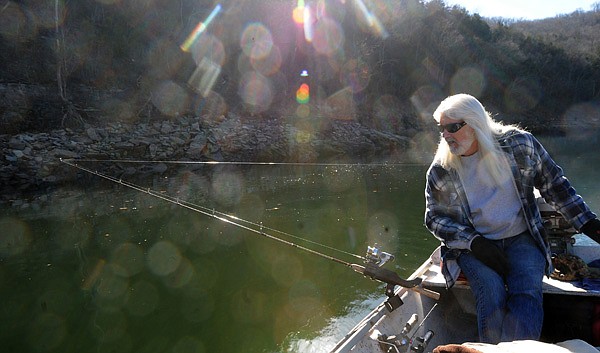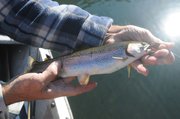Troll With The Flow
SIMPLE TECHNIQUE EFFECTIVE FOR TAILWATER TROUT
Roy Clark, a trout and walleye guide on the White River below Beaver Dam, checks his line while trolling for trout Dec. 13. Clark trolls spoons or floating Rapala lures for trout during winter.
Thursday, December 27, 2012
EUREKA SPRINGS — If Roy Clark makes one cast every half-hour or so when he’s trout fishing, that’s a lot.
Once his lure splashes down in the cold, clear water of the White River below Beaver Dam, it stays there for a good long while.
Trolling is Clark’s favorite way to catch trout, and winter is a prime season to put the technique to the test.
Clark, a trout and walleye guide who lives near Beaver Dam, was the picture of contentment during a morning of trout fishing on Dec. 13, a chilly but sunsplashed Thursday.
Trolling along, he relaxed in the stern of his john boat and let his small outboard do the work. Its 9.9 horses moved the boat along at a slow idle while two lures swam at the end of our lines 100 feet behind the boat.
The White River was a lovely place on this bluebird day, but Clark cautioned catching trout could get tough once the sun climbed high.
“We might get a couple here real quick, then it might die off on us,” he said.
It only took one cast for Clark to catch his first rainbow trout of the day. The 12-inch fish bit his Colorado spoon 15 minutes after the guide started to troll.
SPOON-FED FISH
Two types of lures get the job done when Clark takes customers trout fishing on the river. He might coach them to troll a floating Rapala minnow-style lure for awhile.
When Clark fished on Dec. 13, a plastic box in his boat held Rapalas in several colors.
His favorites are gold with a black back, yellow with a white back or straight chartreuse.
“I use a snap swivel to keep the line from twisting,” Clark said.
“It doesn’t seem to hurt the catch rate at all.”
Later, he might switch to a Colorado spoon. Rainbow trout had an appetite for a gold spoon on this crisp morning. After a couple of fish, we settled on spoons for the rest of our trip.
Clark prefers the lower end of the White River for his trout pursuits. The fish tend to be bigger, he said. Here the river is wider, deeper and better for trolling.
For this trip, Clark launched his boat at Houseman Access, seven miles downstream from Beaver Dam. We fished within a mile upstream or down from the ramp.
A trolling trip we took in October a few years back sticks out in both of our memories.
It proved how large these downstream trout can be.
Big rainbow trout 18 inches and longer, lots of them, attacked the Rapalas we trolled one mile below Houseman Access.
Clark testified it was among his best fishing trips in 23 years as a White River guide.
“That was an exceptional day,” he recalled. “You have a day like that only every now and then.”
We weren’t setting any records on this outing. If we wanted fish for lunch we’d have had a nice mess, but we released every trout.
KEEP IT SIMPLE
Trolling is so easy first-time fishermen can do it. Cast the lure behind the boat, sit in a comfortable seat, maybe kick your feet up on the gunwale.
Hold your fishing rod and feel the lure swim as the boat pulls it slowly along. Or, put your rod in a holder and munch a sandwich.
When a trout hits, the hook usually sets itself.
Clark hasn’t always preached the virtues of trolling. The first time we fished together in the 1980s he was a worm man. Live worms were his bait of choice.
Back then there was a lot more keeping of trout than catch and release.
“When I first moved down here I’d eat out of this river,” Clark said. “When we fished, we’d only take hooks, sinkers and worms.”
A worker at nearby Riverview Resort asked Clark if he was interested in guiding and fished with Clark a time or two.
“I think he wanted to see if I had what it takes,” Clark said.
Trout can be caught several different ways, with live bait, lures and flies. Clark learned something about each method over the years.
Nowadays, Clark uses lures most of the time. On the river, he’s easy to recognize with his thick mane of white hair he’s had all these years.
As predicted, the catching grew tough toward high noon.
The sun felt good, but our fishing day was done.
We agreed to get together again this spring when walleye fishing is prime on the river.
Clark let on how we’ll be fishing then.
Trolling, you guessed it.
Outdoor, Pages 7 on 12/27/2012

